- By Dan Veaner
- Around Town
 Print
Print 
When we heard that my father-in-law Carl was going on an honor flight, my wife contacted the organization to see if we could meet the flight and spend the day with the 80 Minnesota veterans who were participating. To our joy, Carl's Guardian (a person who accompanies and takes care of a veteran the day of the flight) was enthusiastic about family members sharing this incredible experience with veterans, so on Friday (November 1) we hopped in our car and headed for Washington, DC.
"Honor Flight Network is a non-profit organization created solely to honor America’s veterans for all their sacrifices," the Honor Flight Network Web site explains. "We transport our heroes to Washington, D.C. to visit and reflect at their memorials. Top priority is given to the senior veterans – World War II survivors, along with those other veterans who may be terminally ill. Of all of the wars in recent memory, it was World War II that truly threatened our very existence as a nation—and as a culturally diverse, free society. According to the Department of Veterans Affairs, an estimated 640 WWII veterans die each day. Our time to express our thanks to these brave men and women is running out."

I have vivid memories of my late Lansing friend Gray Larison's excitement when he, also a World War II veteran, participated in an honor flight that left from Syracuse. So I knew Carl was in for an amazing and unique experience. Despite a parade celebrating the Washington DC Nationals winning the world series that forced the honor flight buses to deviate from their normal route, the experience didn't disappoint. Veterans from World War II, and the Korean and Viet Nam wars packed three buses with their Guardians and tour guides in a long, joyous day of remembrance and honor.
The veterans' day began Saturday morning at 5am (6pm Eastern Time) at the Minneapolis Airport, when they arrived to catch their charter flight. It would be a long day -- the buses would make nine stops before the vets got on a return flight that arrived back in Minneapolis at 10:30pm Central Time. They had Mail Call during the flight, receiving a multitude of cards and letters and printouts of emails that had been sent via their Guardians from friends, family, and well wishers in time to make it onto the flight.
When my wife and I got to Ronald Reagan Washington National Airport, an easy trip from our hotel on the Metro, we found an Honor Flight 'Ground Crew' waiting in a reception area where the veterans would emerge from the gate. A quite good string ensemble was playing patriotic songs and tunes from the 1940s. Announcements were made on the airport PA inviting people to come welcome the veterans. Excitement built as we saw the Sun Country plane roll up to the gate, and at last the first veterans walked through the reception area.
One of the 'Ground Crew' told us that during the good weather season 70 honor flights per month fly into Reagan Washington Airport. She said that does not include honor flights that come through the other two Washington airports. Many of the volunteers have participated in many honor flights. Carl's guardian Gaylen Johnson told me that after the emotional and wonderful experience he had when he served as a guardian for the first time, he was bitten by the bug. This was his 17th honor flight as a guardian.
Veterans wore maroon T-shirts that said 'Minnesota Veteran' on the back, while the guardians were decked out in yellow Ts. Many of the veterans wore baseball caps that said 'World War II Veteran, or 'Korea Veteran' or Vietnam Era Veteran'. And many of them were in wheel chairs, for the most part because of their age. The Guardians made sure they had whatever they needed during the day.
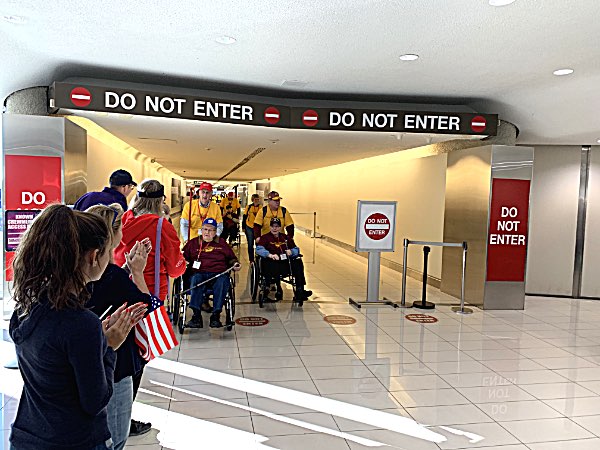 The veterans arrive
The veterans arrive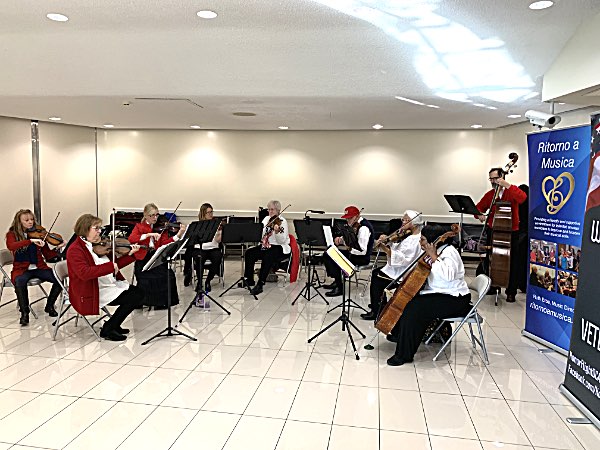 Ritomo a Musica string ensemble greeted the veterans when they arrived in Washington
Ritomo a Musica string ensemble greeted the veterans when they arrived in Washington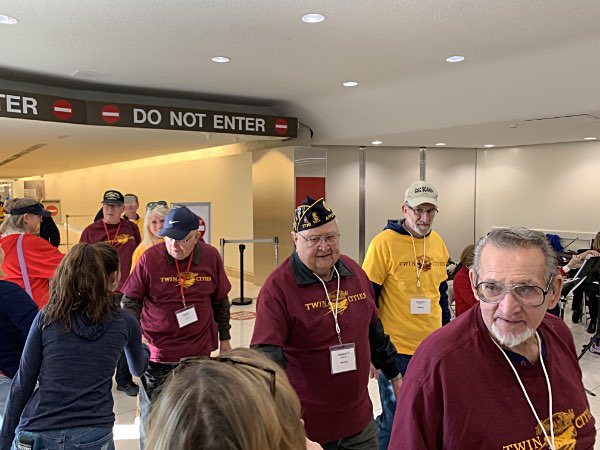 Coming off the plain at Reagan Washington Airport
Coming off the plain at Reagan Washington Airport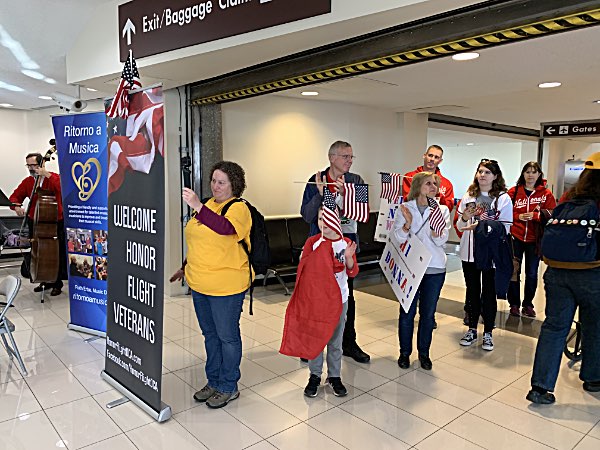 Waiting to welcome the veterans
Waiting to welcome the veterans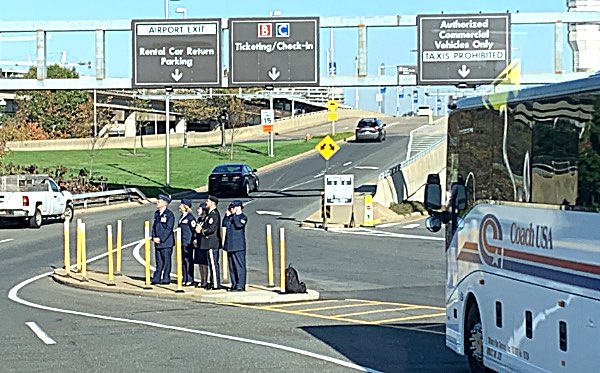 Leaving the airport
Leaving the airportWell wishers, both military and civilian, were part of the experience all day. Formal greetings at the airport and on the way to dinner were part of it, but at each stop people saw the maroon 'Minnesota Veteran' shirts and the veteran caps and wanted to shake the vets' hands and thank them for their service.
I've known Carl for about 40 years, and I knew he was enthusiastic about the time he served during World War II. He actually enlisted in the Navy, then served in the Army (his favorite time as a member of the 1st Cavalry) during the occupation of Japan. After that he joined the Air Force. He had his own horse as a member of the Cavalry in Japan. At the time of his discharges, he was an Apprentice Seaman in the Navy, a Corporal in the Army, and a Staff Sergeant in the Air Force.
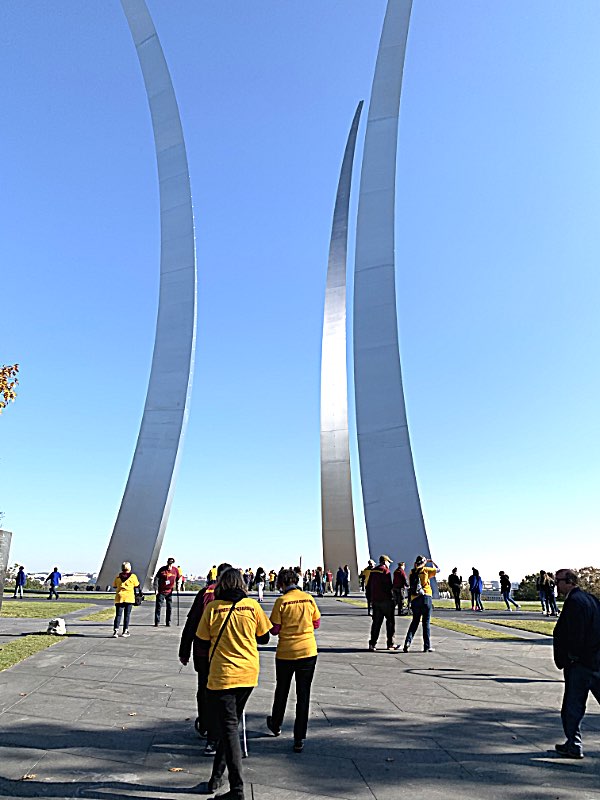
 Guardian Gaylen Johnson and Carl at the Air Force Memorial
Guardian Gaylen Johnson and Carl at the Air Force Memorial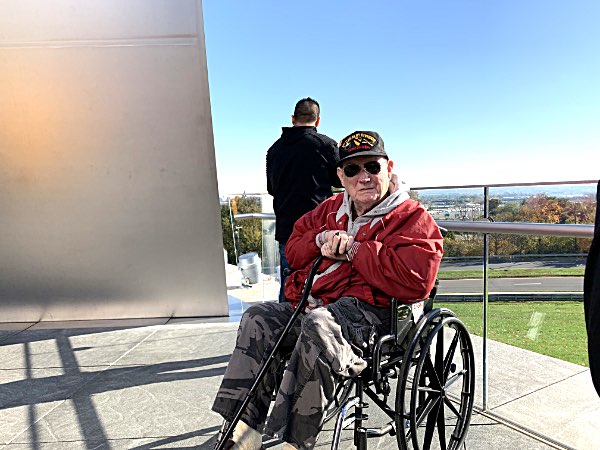 Carl at the foot on one of the three giant spires at the Air Force Memorial
Carl at the foot on one of the three giant spires at the Air Force MemorialThe first stop was the Air Force memorial, which features three elegant spires reaching for the sky. The highlight of the visit was a ceremony featuring Air Force members lining up and saluting while a bugler played Taps. Many well wishers approached the veterans, and it was some time before everyone got back on the bus.
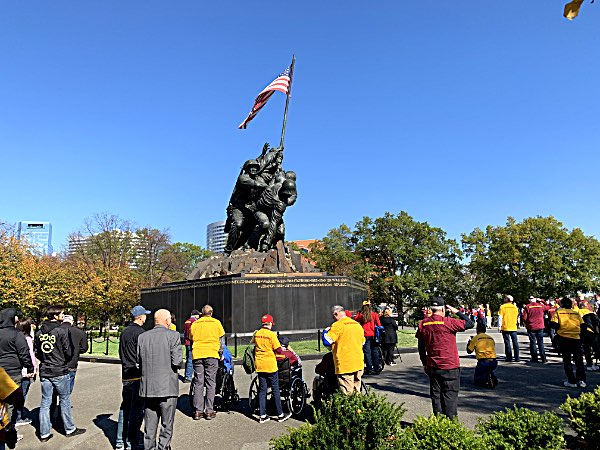 The Island of Iwo Jima was captured from the Japanese Imperial Army by the US Marines and Navy during a major World War II battle February 19th through March 26th in 1945
The Island of Iwo Jima was captured from the Japanese Imperial Army by the US Marines and Navy during a major World War II battle February 19th through March 26th in 1945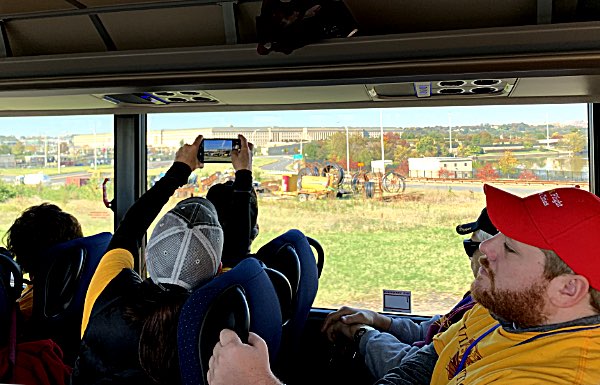 The Pentagon
The PentagonThe next stop was the Iwo Jima Memorial, followed by a box lunch at the Navy Yard Museum. It wasn't possible to drive by the White House and Capital Building because of the baseball parade, but the buses did pass by most of the sides of the Pentagon.
After lunch was a visit to the World War II memorial, a big oval plaza with the European part of the war at one end, and the Pacific portion at the other end. Stones commemorating veterans from each state circle the memorial, with a large plaza and reflecting pools.
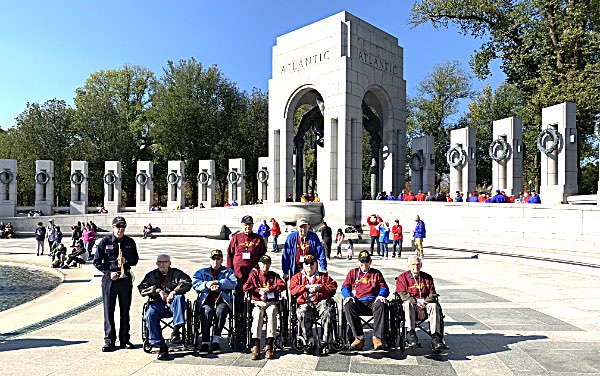 WWII Vets conducting a Taps ceremony at the WW II Memorial
WWII Vets conducting a Taps ceremony at the WW II Memorial
 Minesota WW II Veterans
Minesota WW II Veterans
At one point I was alone with Carl, and he very emotionally told me "I'm no hero. I wasn't in the way of bullets in the war." I told him that he is a hero, because the people who were in front of bullets couldn't do what they did unless he was there to do what he did. He replied that I couldn't convince him of that. I found that many vets feel this way, and most are modest about what they did in the war. I knew that many don't like to talk about their experiences except with other veterans. Growing up I was hardly aware that my own father had served in the Navy at the end of World War II. But this group of vets seemed genuinely touched when people came up to greet them.
Next stop was the Korean and Vietnam War memorials, and again Taps ceremonies were part of the visit.
The highlight of the day was a visit to Arlington National Cemetery to witness the changing of the guard at the Tomb of the Unknown Soldier, and then the lowering of the American Flag for the day. The tomb is guarded 24/7 by Sentinels, or Tomb Guards from the 3rd U.S. Infantry Regiment who are privileged to be chosen for the duty. Carl told us this was his favorite part of the day, the most moving.
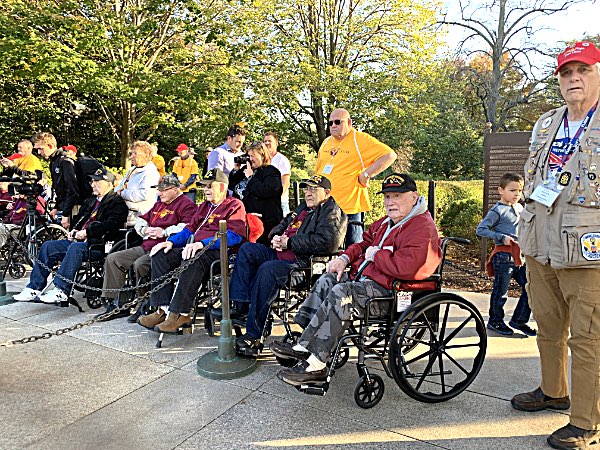 Honor Flight veterans watching the changing of the guard at the Tomb of the Unknown Soldier
Honor Flight veterans watching the changing of the guard at the Tomb of the Unknown Soldier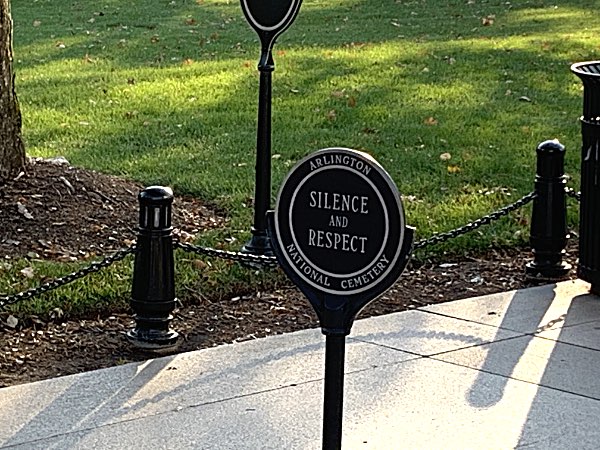
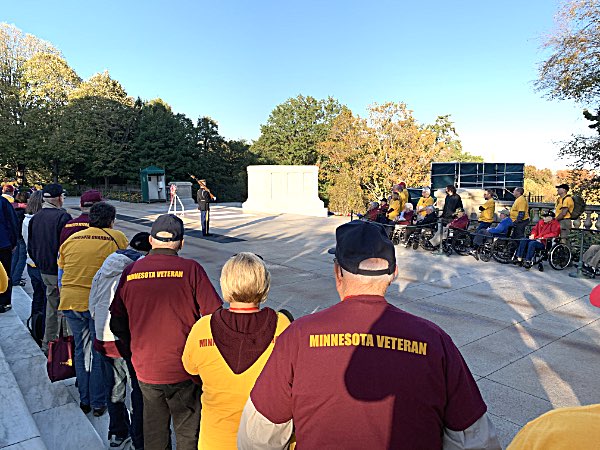 Watching the Changing of the Guard at the Tomb of the Unknown Soldier at Arlington National Cemetery
Watching the Changing of the Guard at the Tomb of the Unknown Soldier at Arlington National Cemetery The lowering of the flag at the end of the day at Arlington National Cemetary
The lowering of the flag at the end of the day at Arlington National Cemetary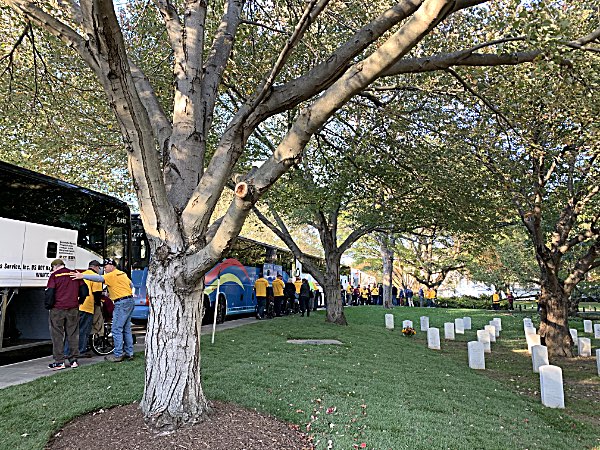
The final stop was the Columbus Club, where the Knights of Columbus hosted a dinner for the veterans. On the bus the vets joked about getting a lobster dinner, but the actual main course was meat loaf. Girl Scouts and Boy Scouts were among the greeters at the entrance way, all wanting to shake hands and say thank you to the veterans.
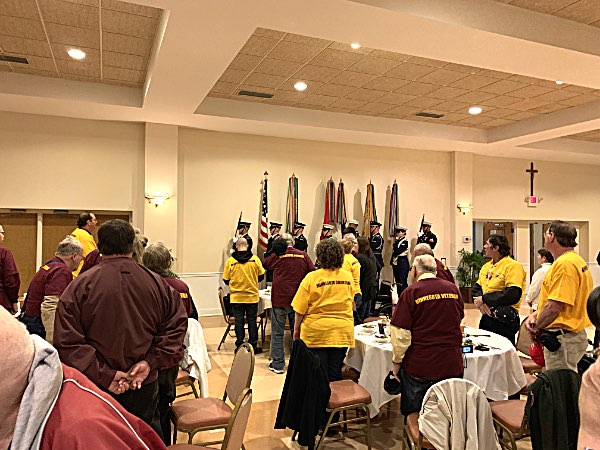 Presentation of the Colors at the Columbus Club in Arlington
Presentation of the Colors at the Columbus Club in ArlingtonThe large dining room had a stage at one end with an enormous American flag providing the backdrop. Everyone stood for a Presentation of the Colors and the Pledge of Allegiance, before sitting down to dinner (the meatloaf was good!). After dinner Deputy Secretary of the Department of Veterans Affairs James Byrne was the featured speaker.
"I have the best job in the world, leading an agency that provides care benefits and services for deserving veterans," he said."That's what the President has directed us to do. That's what the American people have directed us to do. An I am really privileged to be at the Department of Veterans Affairs, and I appreciate you allowing me to speak to you today."
He said he would be visiting the VA hospital in Minneapolis an November 20th and invited the veterans to approach him if they happened to see him there.
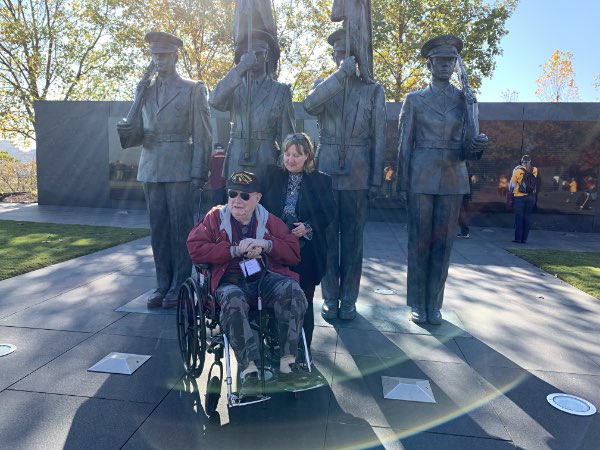 Father and Daughter
Father and DaughterNext was a bus ride back to the airport, and a flight back to Minneapolis.
But that doesn't end the honor flight. On November 17th a reunion was held in Roseville , Minnesota. The veterans were given books and a DVD with pictures and video of their flight that were taken by photographers who accompanied the flight.
For us the day was great on many counts. When I was in high school veterans coming home from Vietnam were not treated well by the public. They took the heat for political decisions that led to an unpopular war. That has changed quite a bit. Today it has become popular to thank veterans for their service, and to honor them for what they risked for our country and to preserve our way of life. Seeing these veterans being revered by so many people was outstanding, and seeing the light in their eyes when people came to honor them was even better. I often refer to Carl as my favorite father-in-law, and even if I had more than one I think he'd be my favorite. And of course he is my wife's favorite father. Getting to spend such a special day with him was one of the best things we could do, especially at this time of his life. And it was a great honor to be allowed to tag along with so many amazing people, the veterans and Guardians (many of who are also vets) alike.
The Honor Flight Network has a waiting list of over 38,000 veterans. They sponsor flights from 45 states using 130 hubs, including nine in New York. 21,189 veterans flew in 2018, including 2,702 from World War II, 7,456 from the Korean War, 10,272 Vietnam veterans, and 759 others. 222,133 veterans have gone on honor flights since 2005.
v15i45



